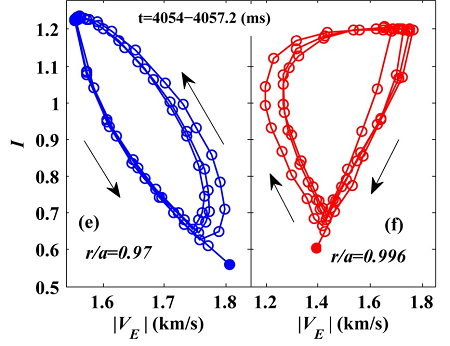
count: [2016-06-01] [Close]
ASIPP’s research work on low-to-high (L-H) confinement transition is included in the exclusive Nuclear Fusion 2015 Highlights collection recently, the fifth time that EAST team’s work has been selected in NF annual hightlights collection consecutively since 2011.
After decades of H-mode studies on different magnetic confinement fusion experimental devices, it is found that the L-H transition requires sufficient heating power, known as the L–H transition power threshold, and if the input heating power is close to the transition threshold, an intermediate phase, or limit-cycle oscillation (LCO), appears prior to the final transition into the H-mode.
In order to understand these experimental phenomena, EAST team established a dynamic model in one-dimensional radial space to analyze the connection between the dynamics of microscopic turbulence and the macroscale power scaling during L-H transition.
As presented in this article, analysis indicates that the physics of the microscopic turbulence dynamics and the macroscale H-mode power scaling of the L-H transition are one thing with two aspects. Before the positive feedback of the diamagnetic drift velocity becomes dominating, the negative feedback between turbulence and poloidal flow will sustain the limit cycle oscillation during the L-H transition. It is revealed that there are two different oscillation relationships between the ExB flow and the turbulence intensity depending on which oscillation of the diamagnetic drift velocity or poloidal flow is dominant. The dominant role of the diamagnetic drift velocity in the ExB flow shows a linear dependence of the H-mode access power on the density and magnetic field. The establishment of this physical model provides a powerful analytical tool for the interpretation of experimental phenomena and the prediction of the L-H transition of the future devices.
The previous articles of EAST team included in NF highlights covers:
Study on H-mode access at low density with lower hybrid current drive and lithium-wall coatings on the EAST superconducting tokamak (2011)
Observation of a new turbulence-driven limit-cycle state in H-modes with lower hybrid current drive and lithium-wall conditioning in the EAST superconducting tokamak (2012)
Progress of long pulse and H-mode experiments in EAST (2013)
Dynamics of L–H transition and I-phase in EAST (2014)
One-dimensional modelling of limit-cycle oscillation and H-mode power scaling (2015)
Links to 2011-2015 NF highlights:
http://iopscience.iop.org/journal/0029-5515/page/Highlights-of-2015
http://iopscience.iop.org/journal/0029-5515/page/Highlights-of-2014
http://iopscience.iop.org/journal/0029-5515/page/Highlights-of-2013
http://iopscience.iop.org/journal/0029-5515/page/highlights-2012
http://iopscience.iop.org/journal/0029-5515/page/Highlights%20of%202011
(ZHAO Nan reports)


FigurOne-dimensional modelling of limit-cycle oscillation reveals two different oscillation relationships between the ExB flow and the turbulence intensity, and the limit cycle near the separatrix is in close compliance with EAST edge probe measurements. (a) turbulence intensity, (b)ExB flow, (c) diamagnetic flow,(d) poloidal flow, (e,f) the plots of ExB velocity vs. turbulence intensity at different radial locations.